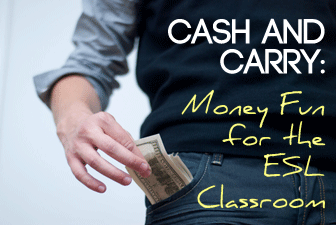Some people have got to have it. Some people really need it. Some people love it, and some people hate it.
It is lost and gained and wasted and earned every single day. It is money, and it is a part of everyone’s life in some way or another. Not only that, money is a topic worth discussing in the ESL classroom. The following activities can help your students learn more about the U.S. monetary system as well as what people do with money in other countries. Why not give them a try? They’re free!

How to Have Fun with Money in Your ESL Classroom
-
1
Foreign Dollars
Part of the challenge for many students who travel overseas is getting used to the monetary system in their host country. Not only do internationals have to think about the exchange rates when they make purchases, they often have to work with a new system of money with different units and different breakdowns of those units. How familiar are your students with U.S. money? They may not know as much as they think. You can give them these simple questions to discuss in groups as you start your money activities.
- Does the U.S. feature any states on its money? (Yes, each state has a quarter designed to feature it.)
- Is there anyone portrayed on a bill that is not a president? (Yes, Alexander Hamilton is pictured on the $10 bill and, Benjamin Franklin is pictured on the $100 bill, Salmon Chase is pictures on the $10,000 bill.)
- What is the next denomination after the $1 bill? (The $2 bill)
- What U.S. coins can you name and what amounts are they worth? ($.01 penny, $.05 nickel, $.10 dime, $.25 quarter, $.50 half dollar, $1 dollar coin)
- What is the largest denomination in U.S. bills? ($100,000 though they were only minted for less than one month between 1934 and 1935 and were not circulated among the public.)
-
2
Two Dollars, Please
Have your students ever seen a two-dollar bill? Many of them may not have since there are so fewer in circulation than other denominations of U.S. bills. Ask for a two-dollar bill the next time you are in your local bank, and bring it in for your students to examine. This may be the first time they have ever seen one. Ask your students to do a little research about the two-dollar bill (or another denomination of their choice) and create a brochure which gives information about the paper money. Each person or group should research the history of their bill and share it in the brochure. They should also include a picture of both sides of the bill and information on when and why it was created. If you like, have each person make an additional brochure featuring a piece of money used in his home country. You can then make the brochures available to your students during independent reading periods so they can learn a little more about their classmates’ native countries.
-
3
Counterfeit Bills
Ask your class if anyone can explain the meaning of the word ‘counterfeit’. There are several lengths to which the U.S. government goes to prevent counterfeiting. If you have computers available in your classroom, send your students to the Internet to read about how to detect counterfeit bills. This survival guide mentions nine different things to look for when testing a bill’s authenticity. Have your students work in pairs to read the article and then list the nine tips for detecting counterfeit bills. You may want to encourage your students to look at an authentic piece of money as they read. To follow up the activity, ask your students to share either with a partner or in a written response what they would do if they found they had received a counterfeit $100 bill. Ask volunteers to share their response with the class.
-
4
What a Bargain
In many cultures, it is appropriate to bargain with a merchant before purchasing his products. If any of your students come from cultures where bargaining is typical, ask them to share some tips on how to bargain with a merchant (certain phrases he should use, maintaining a friendly attitude, etc.) As a large scale classroom role-play, you can create your own market in which your students will bargain for the things that they need. Have each person think of something he uses on a daily basis that he would like to sell in the classroom market. Then give everyone in class $20 in play money to use in the market. Have half of the class be shoppers and the other half merchants and role-play, encouraging each person in class to get all the items he or she would need for a day. Then change rolls and let the shoppers be the sellers and vice versa. Finish by giving everyone an opportunity to shop again, at the same time, and see how many people choose to shop and how many choose to sell. When the activity is over, see who has all the items they would need to go through a day and see who has the most money. Which is more important to each person?
Most people use money on a daily basis, and travelers to foreign countries face a learning curve when it comes to using an unfamiliar monetary system.
With these activities, you can not only help your students learn more about U.S. money, you can also help them become more knowledgeable consumers as they trade and sell in a class market!
P.S. If you enjoyed this article, please help spread it by clicking one of those sharing buttons below. And if you are interested in more, you should follow our Facebook page where we share more about creative, non-boring ways to teach English.







